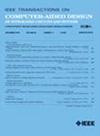Efficient and Scalable Post-Layout Optimization for Field-Coupled Nanotechnologies
IF 2.9
3区 计算机科学
Q2 COMPUTER SCIENCE, HARDWARE & ARCHITECTURE
IEEE Transactions on Computer-Aided Design of Integrated Circuits and Systems
Pub Date : 2025-03-07
DOI:10.1109/TCAD.2025.3549354
引用次数: 0
Abstract
As conventional computing technologies approach their physical limits, the quest for increased computational power intensifies, heightening interest in post-CMOS technologies. Among these, Field-coupled Nanocomputing (FCN), which operates through the repulsion of physical fields at the nanoscale, emerges as a promising alternative. However, realizing specific functionalities within this technology necessitates the development of dedicated FCN physical design methods. Although various methods have been proposed, their reliance on heuristic approaches often results in suboptimal quality, highlighting a significant opportunity for enhancement. In the realm of conventional CMOS design, post-layout optimization techniques are employed to capitalize on this potential, yet such methods for FCN are either not scalable or lack efficiency. This work bridges this gap by introducing the first scalable and efficient post-layout optimization algorithm for FCN. Experimental evaluations demonstrate the efficiency of this approach: when applied to layouts obtained by a state-of-the-art heuristic method, the proposed post-layout optimization achieves area reductions of up to场耦合纳米技术的高效可扩展后布局优化
随着传统计算技术接近其物理极限,对提高计算能力的追求加剧,提高了对后cmos技术的兴趣。其中,场耦合纳米计算(FCN)是一种很有前途的替代方案,它通过纳米尺度上物理场的排斥力进行操作。然而,在该技术中实现特定功能需要开发专用的FCN物理设计方法。尽管已经提出了各种方法,但它们对启发式方法的依赖往往导致次优质量,突出了重要的增强机会。在传统的CMOS设计领域,布局后优化技术被用来利用这种潜力,但这种方法对于FCN要么不可扩展,要么缺乏效率。这项工作通过引入FCN的第一个可扩展和高效的布局后优化算法来弥补这一差距。实验评估证明了该方法的有效性:当应用于由最先进的启发式方法获得的布局时,所提出的布局后优化实现了高达$ {\mathrm{73.75~\%}}~(平均{\mathrm{45.58~\%}}$)的面积缩减。这一显著的改进强调了FCN布局后优化的变革潜力。此外,与现有算法不同,该方法即使在优化超过2000万块的布局时也具有可扩展性。所提出的方法的实现作为慕尼黑纳米技术工具包(MNT)的一部分在https://github.com/cda-tum/fiction公开可用。
本文章由计算机程序翻译,如有差异,请以英文原文为准。
求助全文
约1分钟内获得全文
求助全文
来源期刊
CiteScore
5.60
自引率
13.80%
发文量
500
审稿时长
7 months
期刊介绍:
The purpose of this Transactions is to publish papers of interest to individuals in the area of computer-aided design of integrated circuits and systems composed of analog, digital, mixed-signal, optical, or microwave components. The aids include methods, models, algorithms, and man-machine interfaces for system-level, physical and logical design including: planning, synthesis, partitioning, modeling, simulation, layout, verification, testing, hardware-software co-design and documentation of integrated circuit and system designs of all complexities. Design tools and techniques for evaluating and designing integrated circuits and systems for metrics such as performance, power, reliability, testability, and security are a focus.

 求助内容:
求助内容: 应助结果提醒方式:
应助结果提醒方式:


